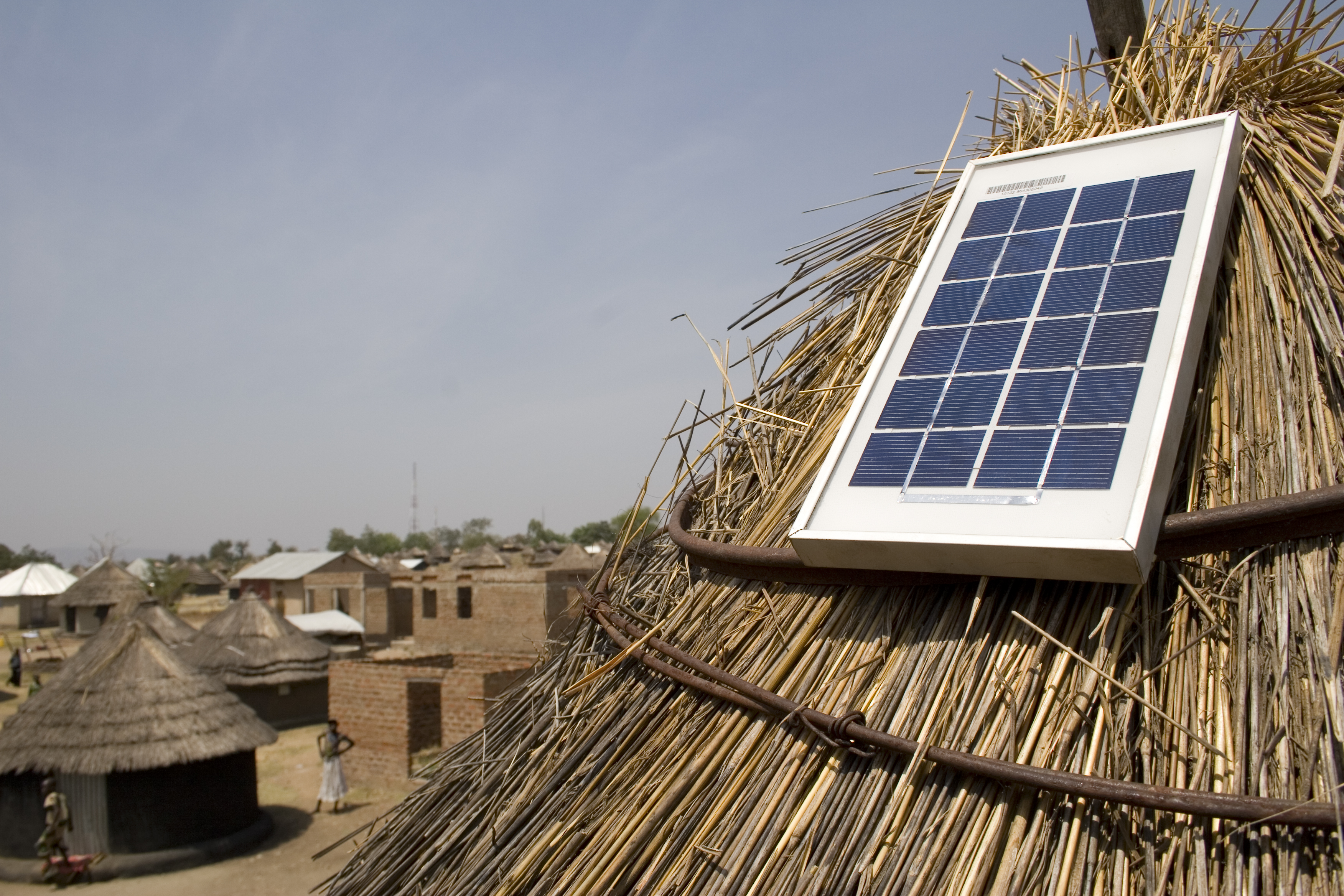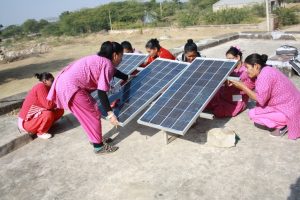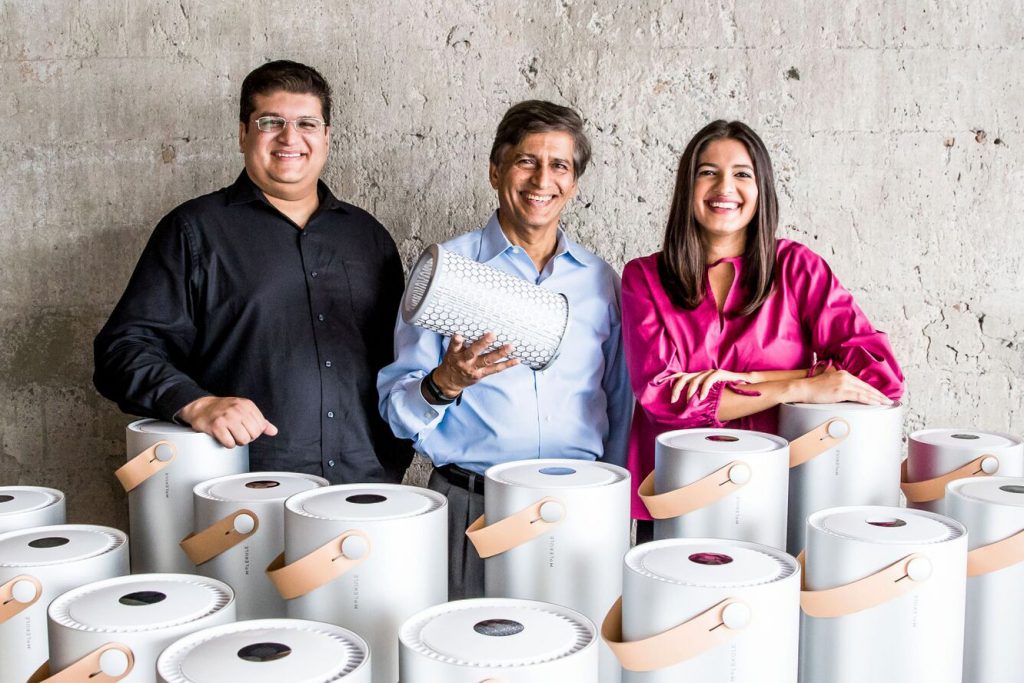We are now living in the most modern and technologically advanced period in history, opening up countless opportunities never thought possible twenty or even ten years ago. From the Internet to smartphones, from aeroplanes to electric cars – we are the most connected and progressive we’ve ever been as a society. While technological advancement has significantly improved the quality of life for some, it also creates a looming problem threatening this progress: energy security.
Technological progress has made us much more energy intensive. World electricity demand increased by over 183 percent from 1980 to 2014, and this is set to increase at least another 28 percent by 2040. This surge is happening particularly in non-OECD countries, who are undergoing rapid development and modernisation. In India, electricity demand has grown 8 times since the 1970’s in part because per capita electricity consumption in India is still less than one-third of the global average. (World Bank) However, nearly 1.1 billion people are still considered to be energy insecure (UNDP). A startling one in five people still lack access to modern electricity (UNDP) – this means that one in five people don’t benefit from the technological advancements that enable an improved quality of life. Having access to energy will be essential to remedy extreme inequalities and is quite literally the key element that will power all other development activities.
IN THE PHOTO: Solar farm in Morocco. CREDIT: UNHCR
The question is not simply how can we produce and distribute more energy to solve the energy security problem. The real challenge is how can we produce the energy we need in a way that will be sustainable long-term and won’t further impoverish the lives of those that are already the most vulnerable. Energy production activities have typically been in the fossil-fuel oil, coal and gas sectors in the developing world. While these activities indeed produce more energy in these countries, they also contribute to the deterioration of the environment, contributing to global warming, decreasing quality of the life in the region instead of improving it. Furthermore, this energy is often immediately exported to more industrialised countries or at a price too high for those below the poverty line to afford. Altogether, energy produced through ‘traditional’ fossil-fuels increases inequalities rather than catalysing development. Therefore, Sustainable Development Goal 7 doesn’t simply call for access to energy, but access to clean and affordable energy. These two requirements will be the game changers we need to ensure sustainable development.
Most developing countries are located in regions with optimal access to the sun’s rays and therefore have an attractive potential opportunity to harness the power of the sun. Solar power can be both a clean and affordable energy – fulfilling the important criteria of SDG 7. Not only this, but many countries are beginning to embrace solar power as a solution to many issues they face as they develop including economic growth, health, education, gender equality, food security and of course climate change. Solar panel systems represented 19 percent of new generating capacity in developing countries in 2017, up from just 10.6 percent the year prior – this is enough to power all homes in Peru or Nigeria (BNEF). Millions of dollars have been given to organisations and governments to fund solar projects to power development activities, most of which have seen great success. Solar power could be the bright light we need at the end of the long, dark development tunnel. There are solar power systems and devices that you can install at home with the help of a residential electrical contractor if you want your home to be more energy-efficient.
IN THE PHOTO: Honduran women powering their business. CREDIT: UNDP
Clean and affordable energy for all
Solar is the fastest-growing new energy source in the world, and it is still only scratching the surface of its potential. This technology is continually exceeding everyone’s expectations and has scaled up faster than even the most optimistic forecasts. The surge in solar is primarily due to a dramatic reduction in cost. Sixty years ago, the price of solar panels was an astronomical $1,910 per watt which made it a very niche energy source. Solar is now one of the cheapest forms of energy in over 60 countries, as prices of installation have dropped by 75 percent since 2009 and are projected to decrease another 75 percent by 2025, as more solar is deployed and technological improvements occur. (IEA) With these radical decreases in installation price, the levelised cost of electricity (LCOE) will follow suit and could drop by 59 percent from 0.13 to 0.06 $US/kWh by 2025. (IRENA) Today, the cheapest electricity in the world is powered by solar, with electricity costing a mere 1.77¢/kWh thanks to a solar project in Mexico. (Greentech Media) Solar is no longer a niche energy source and has now become the first choice for many due to its newfound affordability.
These dropping prices are especially noticeable in developing countries. In 2015, developing countries invested more in renewable energy than industrialised countries. (Ren21) Solar auctions in developing countries have produced astonishingly cheap electricity way below the prices of electricity generated by coal and gas, which tend to be quite expensive in these countries. (BNEF) In 2009, a radio, a mobile-phone charger, and a solar system big enough to provide four hours of light and television a day would have cost a Kenyan a $1,000 – now it is $350. (Off-Grid Electric) Because of this, developing countries have added 34GW of solar capacity over the last year, which is an impressive 54 percent increase, up from 3GW in 2011. Another factor adding to the affordability of solar in developing countries compared to more industrialised countries is that these countries do not have the pre-established infrastructure that industrialised countries have, that are built to facilitate traditional energy sources such as coal and gas. This means that developing countries can directly benefit from solar’s cheap prices and do not have to worry about the costs of transforming the energy system that tend to hold back solar’s deployment in industrialised countries. Developing countries are opting for solar not just because it is a clean, renewable energy, but also because it is simply the cheapest option.
Finding your place in the sun
According to campingfunzone.com solar is also an attractive option for developing countries because of its scalability. From large-scale solar farms to micro-grids, to solar-powered lights – solar can offer a solution to many different problems a community may be facing. Large solar farms can provide the greatest amount of energy for a country and are therefore essential for quickly meeting a growing electricity demand, especially in urban centres. These farms are also the most effective option for producing energy compared to other energy sources. Large solar farms can be built in just a few months, whereas a coal or nuclear plant will take several years or longer. Solar can therefore quickly give people access to much-needed energy without the health or environmental damages of other energy sources.
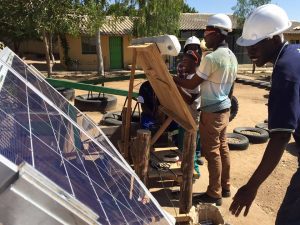
IN THE PHOTO: Solar power jobs. CREDIT: World Policy Institute
While large-scale solar farms are an amazing option to quickly produce mass amounts of energy, not many developing countries have the available capital to finance these projects. Furthermore, many developing countries have largely rural populations who may or may not be connected to the grid. In India for example, 300 million people lack access to the electricity grid. (World Bank) This is why micro-grid and small-scale solar solutions have become particularly popular to power development activities. Micro-grids offer a flexible solution because costs of installation are spread out throughout the community, making them cheaper and facilitating deployment. In addition, micro-grids decentralise the energy supply to provide more reliable power directly to those who need it in a much more efficient way than the traditional centralised energy production systems. Micro-grids utilising solar have been shown to provide higher quality energy services at the same or lower costs than alternatives. With four solar panels and four batteries, a micro-grid can provide enough power for 100 Indian households with the households paying a very affordable price of only 50 cents per week. (Mera Gao Power)
Many households in developing countries are also installing their own rooftop solar as a solution to their energy needs. More than 1.5 million households in Africa now use solar home systems that were bought on a mobile-money enabled financing plan, up from just 600,000 at the end of 2015. (SE4ALL) These home solar systems turn households into energy prosumers, giving them back the power to control their energy access instead of being dependent on a third party. It is now not an uncommon sight to see a home in Africa with a solar panel placed on its roof. Other small-scale solar technologies such as solar-powered water pumps, streetlamps, and ovens can all be found in even the most rural villages to help communities meet their energy and other basic needs. This juxtaposition between traditional villages and modern technology is at the core of a sustainable development model and offers those in developing countries the tools to be agents of their own development instead of subjects. From a massive solar farm to a solar-powered flashlight, solar can bring countless solutions to developing countries for affordable, reliable and effective energy no matter where you are.
(Solar) powering development
Although solar is an obvious contributor to SDG 7 in providing clean and affordable energy, it can help power many more sustainable development goals as it can be the foundation for all other development opportunities. There is growing evidence that access to a reliable and affordable supply of energy is directly linked to socioeconomic benefits. (World Bank) One of the most visible benefits is on the environment. Climate change, which is considered as one of the greatest challenges of our time, can potentially undermine country efforts towards sustainable development targets. (SDG 13) Instead of investing in polluting energy sources which destroy the environment and contribute to poor air, water, and land quality, investing in renewable energy sources such as solar will simultaneously fulfil multiple Sustainable Development Goals. Developing countries are a major part of the Paris Agreement and have made significant efforts to commit to lowering their increasing carbon emissions as they undergo the development process. In order to lower emissions without stymieing their growth, renewable energy sources such as solar play an increasingly important role.
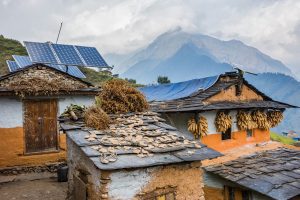
IN THE PHOTO: Rooftop solar in Nepal. CREDIT: Shutterstock
Not only does embracing solar help developing countries meet their Paris Agreement commitments in an affordable way, but it also helps to boost economic growth. Solar itself can provide thousands of new jobs and opportunities for people in developing countries, which are much more stable and safer than jobs in other energy sectors. (SDG 8) Furthermore, solar can help facilitate the growth of other economic activities in communities which can power development from the bottom-up. The solar industry opens up endless opportunities for entrepreneurs, as new business models emerge to provide infrastructure for electricity production and supply that weren’t there before in a centralised system. (SDG 9) For example, micro-enterprise centres powered by solar have now opened up in many developing countries. (UN) These centres provide the power that people need to enable their small businesses, whether it be providing an outlet to charge their smartphone or turning on the lights in their store, this solar-powered energy is crucial for the success of these businesses.
Solar can provide the energy needed to close the gap between rich and poor, as it can level the playing field and give even the most rural communities the same opportunities as urban centres. (SDG 10) Taking the Internet for example, which is often seen now as an indispensable tool for realising a range of human rights, yet it is accessible for just 40 percent of the globe because of a lack of electricity infrastructure. (TeachSDGs) Without access to the Internet, those in developing countries will continually be one step behind with little prospects for advancement. However, there are now many affordable solar-powered devices available that can power computers and a reliable Internet connection, unleashing a plethora of new opportunities for communities who have historically been at a disadvantage.
Access to the Internet is also an important element in improving education in these communities. (SDG 4) In Africa, 65 percent of primary schools do not have access to electricity. (Green Alliance) Without proper electricity, this greatly limits the time and resources that can be used for educational purposes. Many schools are now powered by solar in developing countries, providing the energy needed for the school and power important resources like computers and Internet connection to further the education of students. Keeping the lights on longer is especially important for adults who want to continue their education but cannot study during the day because of work obligations. On top of this, with solar-powered lamps, children can study an extra hour on average each day, which contributes to greater overall success in school.

IN THE PHOTO: Solar micro-grid in India. CREDIT: Greenpeace
Solar technology is also indispensable in providing basic human rights such as access to food, water, and health care in many developing countries. Farmers now rely on solar-powered irrigation systems produce more food more efficiently, greatly limiting the chance of food insecurity in the case of drought and providing income security for farmers. (SDG 2) When diesel-powered water pumps were replaced with solar-powered pumps in India, there was an amazing 161 percent increase in annual monetary savings for farmers. (IRENA) Given that 40 percent of the world’s population incomes depend on the agriculture sector, a majority of whom live in poverty, providing reliable systems such as solar irrigation is an important tool for overall poverty alleviation. (SDG 1) These solar-powered pumps are also important in delivering clean water to communities, saving them countless hours fetching water and allowing them to focus their efforts instead on growth opportunities instead of just survival. (SDG 6)
Finally, solar is an important element for ensuring health care in many developing communities. (SDG 3) First of all, because it is a clean energy source, it does not contribute to the air pollution which plagues many developing countries and contributes to many diseases and overall health deterioration. Second of all, solar helps to power more modern and effective health facilities. From clinics to operating rooms, to laboratories – health facilities rely on electricity to power the lights, refrigerate vaccines, and operate life-saving medical devices. Yet only 34 percent of hospitals in sub-Saharan Africa have reliable access to electricity. (UNDP) The installation of solar systems on health facilities is seen as one of the most effective solutions to provide constant and cost-effective access to electricity. Solar energy also results in lower power bills for health facilities, who can then reinvest these savings to improve their health services.
Altogether one thing is clear – solar is not just a source of power, it is also a source of empowerment for many developing countries.
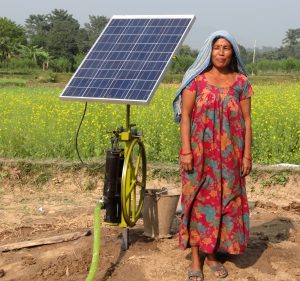
IN THE PHOTO: Solar-power irrigation pump. CREDIT: Futurepump
Keeping the lights on
Solar offers many solutions big and small to put communities on the right track for sustainable development, yet even with the relatively cheap costs of this technology, many impoverished communities are still unable to afford this powerful development tool. It is estimated that in order to achieve universal access to modern energy services, annual investments of $45 billion will be needed to meet the goals. (World Bank) Many programs now exist which work to fund and deliver this potentially life-saving technology to communities who need it most. The World Bank Group has established the Clean Technology Fund and Scaling-Up Renewable Energy Program in Africa which together will provide over $1.1 billion to help power development. (World Bank) Other programs by the Green Climate Fund, the International Renewable Energy Agency, and the Asian Development Bank have all contributed significant investments in order to increase the deployment of solar and other renewable technologies in developing countries.
However, these investments will not be enough to keep the lights on in these communities. One of the most effective ways to mobilise investments in solar and promote sustainable development is through important public-private partnerships. (SDG 17) Many initiatives already exist to promote and facilitate these partnerships such as SE4All, which works to empower leaders to broker partnerships and unlock finance to fund renewable energy projects. Another example is the Alliance for Rural Electrification which is a global industry association supporting businesses along the whole value-chain of renewable solutions for rural electrification in developing countries. The Africa-EU Renewable Energy Cooperation Programme (RECP) offers yet another solution to create public-private partnerships to increase investments in clean energy. This initiative by the EU supports market development by providing critical information on African energy markets, identifying project opportunities through on-the-ground scouting activities, matchmaking between project developers, technology suppliers and service providers for joint project and business developing as well as facilitation of access to finance. Altogether, these initiatives will build important foundations for sustainable economic growth as they will create development opportunities which engage all stakeholders from the bottom-up.
Sustainable development is not some distant, utopian goal – it is entirely possible with the right solutions in place. Solar is one of these solutions. From creating new business opportunities to powering a healthier society and brightening education prospects – solar is a technology that can light the path towards sustainable development.
Co-authored by Alyssa Pek, Communications Assistant, SolarPower Europe

Alyssa Pek is the Communications Assistant at SolarPower Europe. She has previously worked as a Communications Consultant for the European Volunteer Centre in Brussels and the Global Gathering Place, a refugee and immigration help centre, in Canada. Ms Pek holds an MA with Distinction in Political Communication and Strategy with a specialisation in International Development from the University of Kent’s Brussels School of International Studies.
Editors note: The opinions expressed here by Impakter.com columnists are their own, not those of Impakter.com — Featured photo credit: Azuri


